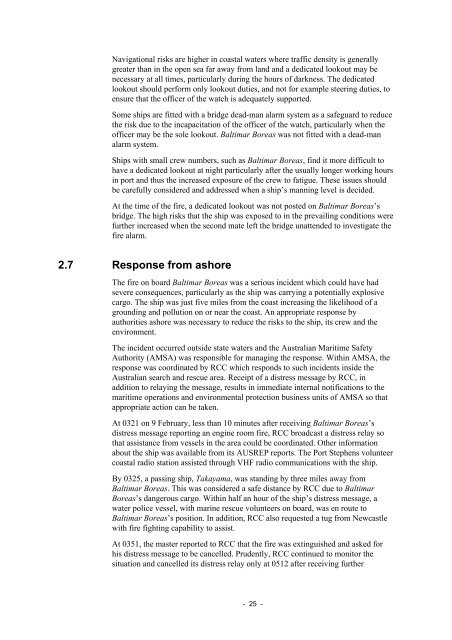Marine Report 236, Independent investigation into the engine room ...
Marine Report 236, Independent investigation into the engine room ...
Marine Report 236, Independent investigation into the engine room ...
Create successful ePaper yourself
Turn your PDF publications into a flip-book with our unique Google optimized e-Paper software.
Navigational risks are higher in coastal waters where traffic density is generally<br />
greater than in <strong>the</strong> open sea far away from land and a dedicated lookout may be<br />
necessary at all times, particularly during <strong>the</strong> hours of darkness. The dedicated<br />
lookout should perform only lookout duties, and not for example steering duties, to<br />
ensure that <strong>the</strong> officer of <strong>the</strong> watch is adequately supported.<br />
Some ships are fitted with a bridge dead-man alarm system as a safeguard to reduce<br />
<strong>the</strong> risk due to <strong>the</strong> incapacitation of <strong>the</strong> officer of <strong>the</strong> watch, particularly when <strong>the</strong><br />
officer may be <strong>the</strong> sole lookout. Baltimar Boreas was not fitted with a dead-man<br />
alarm system.<br />
Ships with small crew numbers, such as Baltimar Boreas, find it more difficult to<br />
have a dedicated lookout at night particularly after <strong>the</strong> usually longer working hours<br />
in port and thus <strong>the</strong> increased exposure of <strong>the</strong> crew to fatigue. These issues should<br />
be carefully considered and addressed when a ship’s manning level is decided.<br />
At <strong>the</strong> time of <strong>the</strong> fire, a dedicated lookout was not posted on Baltimar Boreas’s<br />
bridge. The high risks that <strong>the</strong> ship was exposed to in <strong>the</strong> prevailing conditions were<br />
fur<strong>the</strong>r increased when <strong>the</strong> second mate left <strong>the</strong> bridge unattended to investigate <strong>the</strong><br />
fire alarm.<br />
2.7 Response from ashore<br />
The fire on board Baltimar Boreas was a serious incident which could have had<br />
severe consequences, particularly as <strong>the</strong> ship was carrying a potentially explosive<br />
cargo. The ship was just five miles from <strong>the</strong> coast increasing <strong>the</strong> likelihood of a<br />
grounding and pollution on or near <strong>the</strong> coast. An appropriate response by<br />
authorities ashore was necessary to reduce <strong>the</strong> risks to <strong>the</strong> ship, its crew and <strong>the</strong><br />
environment.<br />
The incident occurred outside state waters and <strong>the</strong> Australian Maritime Safety<br />
Authority (AMSA) was responsible for managing <strong>the</strong> response. Within AMSA, <strong>the</strong><br />
response was coordinated by RCC which responds to such incidents inside <strong>the</strong><br />
Australian search and rescue area. Receipt of a distress message by RCC, in<br />
addition to relaying <strong>the</strong> message, results in immediate internal notifications to <strong>the</strong><br />
maritime operations and environmental protection business units of AMSA so that<br />
appropriate action can be taken.<br />
At 0321 on 9 February, less than 10 minutes after receiving Baltimar Boreas’s<br />
distress message reporting an <strong>engine</strong> <strong>room</strong> fire, RCC broadcast a distress relay so<br />
that assistance from vessels in <strong>the</strong> area could be coordinated. O<strong>the</strong>r information<br />
about <strong>the</strong> ship was available from its AUSREP reports. The Port Stephens volunteer<br />
coastal radio station assisted through VHF radio communications with <strong>the</strong> ship.<br />
By 0325, a passing ship, Takayama, was standing by three miles away from<br />
Baltimar Boreas. This was considered a safe distance by RCC due to Baltimar<br />
Boreas’s dangerous cargo. Within half an hour of <strong>the</strong> ship’s distress message, a<br />
water police vessel, with marine rescue volunteers on board, was en route to<br />
Baltimar Boreas’s position. In addition, RCC also requested a tug from Newcastle<br />
with fire fighting capability to assist.<br />
At 0351, <strong>the</strong> master reported to RCC that <strong>the</strong> fire was extinguished and asked for<br />
his distress message to be cancelled. Prudently, RCC continued to monitor <strong>the</strong><br />
situation and cancelled its distress relay only at 0512 after receiving fur<strong>the</strong>r<br />
- 25 -
















